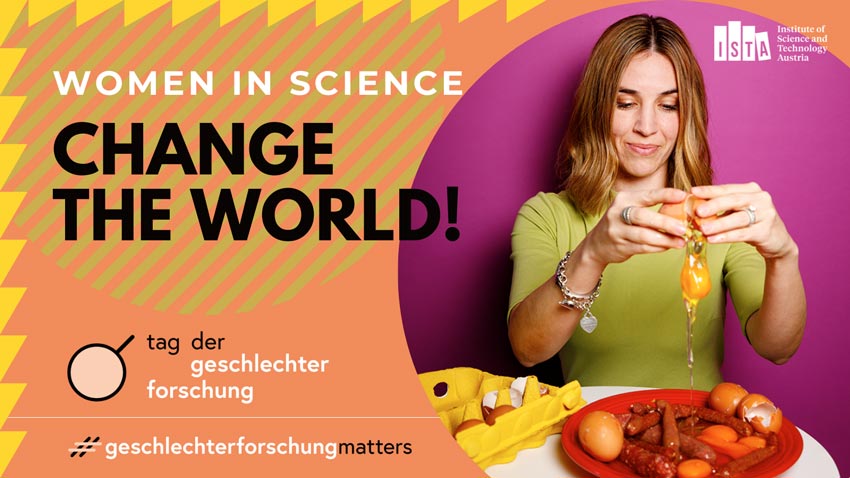March 1, 2022
WoMen in Science: Change the World!
Supporting women and diversity at ISTA

Scientific talent is equally distributed – to exclude any part of the population is to exclude talent. Nevertheless, particularly in STEM fields (science, technology, engineering, and mathematics), women are drastically underrepresented. On the Day of Gender Research, the Institute of Science and Technology Austria (ISTA) puts a spotlight on the problem and shows what can be done for more diversity in science. The day is an initiative by the Austrian Federal Ministry of Education, Science and Research.
Never before have there been more female students. At the beginning of their career, they share the lecture hall in fairly equal numbers with their male colleagues across universities. In some research areas like medicine, women even outnumber their male counterparts. Looking up the scientific career ladder, the picture changes. Among postdocs, men overtake and when it comes to professorship, female professors are a clear minority – a phenomenon called the leaky pipeline. One woman that made it to the top is ISTA-professor Kimberly Modic. “It really is important to change the system because the way it is designed right now we are excluding almost 50 percent of what could be excellent scientists. They could bring a lot: new perspectives, different opinions, and different ways of doing things. It’s a shame to miss out on that because of a system that can’t properly support you to have success as a female,” says the physicist.
Sending signals and taking action
In 2021, the Institute therefore launched a campaign to raise awareness for gender equity in the scientific community and intensified its efforts to change the situation for the better. Regular panel discussions and “STEM fatale” lectures focus on science done by women, the challenges they face, and how to overcome them. The Institute also signed the ALBA declaration on Equity and Inclusion, and establishing a respective working group to create a more inclusive workplace.
Under the motto “Show how to empower!” students, postdocs, and professors alike reflected on gender equity and biases in silent interviews captured by the renowned photographer Peter Rigaud. In one of Professor Modic’s favorite pictures, she pleasurably cracks an egg over a big pile of sausages on a plate. “I wanted to deconstruct the patriarchy,” she explains with a smile. “The eggs are representing women, the sausage are representing men and the idea was: throw a bunch of women into the mix and strengthen the system.”
Another piece of art that invites us to discuss and think outside the box, is the large-scale poster titled “She makes her body glitch” by artist Barbara Kapusta which can be viewed in the center of campus. To inspire girls in particular to pursue careers in so-called STEM fields, students had the opportunity to meet real female ISTA researchers via video calls and ask them anything in a Girl’s special of “Zoom-a-Scientist”.

Proactively solicit applications
“Nonetheless, looking at the numbers of our faculty of 54 male and 14 female professors, we understand very well that raising awareness can only be a very first step,” says ISTA-president Tom Henzinger. Therefore, the Institute has for several years established a faculty recruiting committee actively approaching potential candidates to increase the number of female professors in areas where women are strongly underrepresented.
To make scientific careers more compatible with family life, ISTA offers high-quality daycare for children between three month and six years old directly on campus. Additionally, the Institute helps with finding other childcare services, schools, and job opportunities for partners. To create a welcoming and inclusive environment, ISTA’s administrative staff as well as researchers on all levels are encouraged to participate in cultural awareness trainings, talks, and workshops about respectful communication and the importance of diversity, especially gender equality. As a next step, ISTA is developing a gender equality plan with concrete measures tailored to the Institute.
Committed to equality and inclusion
Besides the efforts the Institute is taking and will continue to take, Henzinger sees an urgent need for action in society as a whole. “Daycare at an early age is often discouraged in Austria and one is considered a bad parent for choosing this option. Starting from kindergarten and elementary school all the way to high school, we also need to present and teach science in a way that inspires female pupils and does not turn them away.”
The diverse experiences and perspectives of people of all genders, as well as all social and cultural backgrounds, enrich science. Diverse teams where everyone feels valued maximize the range of potentially useful ideas and ensure that all group members can give their best. The road to reaching equality and inclusion is long and certainly requires much patience and persistence. As a research institute that also wants to act as a role model for society, ISTA is aware of its responsibility and will continue its efforts towards this goal.



